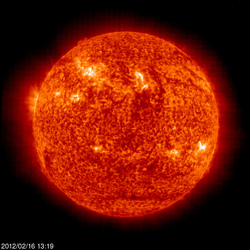 February 16, 2012 John E. Ross, KD8IDJ, Editor
| |||||||||||
+ Available on ARRL Audio News. + WRC-12: Amateur Radio Gets Secondary MF Allocation at WRC-12
It's official -- delegates attending the 2012 World Radiocommunication Conference (WRC-12) have approved a new 7-kilohertz-wide secondary allocation between 472-479 kHz for the Amateur Radio Service. Agenda Item 1.23 had both its first and second readings in Plenary Session on Tuesday, February 14; to become part of the ITU's Radio Regulations, each Agenda Item must be read twice in Plenary Session. While the Final Acts will be signed on Friday, February 17 at the close of the Conference, the new allocation will not take effect until it is entered into the Radio Regulations on January 1, 2013. In any case, no amateur can use the band until his or her national regulations are revised to implement the allocation. Read more here. WRC-12: IARU Vice President Ole Garpestad, LA2RR, Chats with ITU
IARU Vice President Ole Garpestad, LA2RR, sat down for a video interview with the ITU Press Office at 4U1ITU (operating as 4U1WRC), the Amateur Radio station at ITU Headquarters in Geneva. During the interview, IARU Region 1 President Hans Blondeel Timmerman, PB2T, operated CW in the background. Garpestad discussed Agenda Item 1.23 and what it means to the Amateur Radio Service, what the IARU does at the WRC, the future of Amateur Radio, and what the Amateur Radio Service and the IARU are doing for the next WRC. Watch the video here. + WRC-15: WRC-12 Delegates Place Possible 5 MHz Allocation on Agenda for Next WRC One of the responsibilities of each WRC delegation is to set the agenda for the next WRC. WRC-12 delegates approved an Amateur Radio-related agenda item for the upcoming WRC-15: To consider the possibility of making an allocation of an appropriate amount of spectrum, not necessarily contiguous, to the Amateur Service on a secondary basis within the band 5250-5450 kHz. This will be Agenda Item 1.4 at WRC-15.
"It is always a challenge to have items placed on the agenda for future WRCs," IARU President Tim Ellam, VE6SH, told the ARRL. "I am pleased that we were successful in having an Agenda Item for a potential allocation at 5 MHz on a secondary basis. There will be much work to do over the next ITU study group cycle. Much appreciation is owed to the IARU and the national delegation teams in Geneva for their hard work on this issue." According to ARRL Chief Executive Officer David Sumner, K1ZZ, the original 5 MHz proposal came from Cuba. "The IARU team worked hard to line up support," he explained. "The factor that worked most in our favor was that at WRC-07, a proposal for a 5 MHz agenda item for WRC-12 failed to gain enough support, so there was a feeling that the Amateur Service deserved better treatment this time around. We did have active support from a number of administrations in Latin America which helped a lot, but a lot of others also had to agree to get it on the agenda. The coordinators of future Agenda Items on behalf of the regional telecommunications organizations, such as CITEL and CEPT, eventually agreed on a package of Agenda Items that included ours." Read more here. +On the Air: ARRL 500 kHz Experimental Group Sparked Interest in MF Operation In September 2006, the FCC's Office of Engineering and Technology granted a Part 5 experimental license -- WD2XSH -- to the ARRL on behalf of a group of radio amateurs who were interested in investigating spectrum in the vicinity of 500 kHz. Called the ARRL 500 kHz Experiment, this group of hams -- led by Fritz Raab, W1FR -- received permission to experiment and do research between 505-510 kHz using narrowband modes at power levels of up to 20 W effective radiated power (ERP), using CW and PSK31.
The original 500 kHz license called for 23 discrete fixed sites across the US: at Raab's QTH in Vermont, as well as at sites in Arkansas, California, Colorado, Illinois, Louisiana, Massachusetts, Minnesota, Mississippi, New Hampshire, New Jersey, New York, North Carolina, Oregon, Rhode Island, Tennessee, Texas and Virginia. In 2008, the FCC expanded the scope of the experimental license, allowing for more frequencies, more stations and portable operations: The group could now operate between 495-510 kHz, the number of stations increased from 23 to 42 and participants could now operate within 50 km of their designated stations. At the 2012 World Radiocommunication Conference (WRC-2012), delegates approved an amateur secondary MF allocation between 472-479 kHz. The ARRL would like to acknowledge the contributions of the participants in the ARRL 500 kHz Experiment to the recent approval of a new amateur secondary MF allocation, and to thank them for their efforts. Read more here. + On the Air: RAC to Split Ontario into Four Sections
On February 6, Radio Amateurs of Canada (RAC) issued a statement on their website that the Ontario Section would be split into four new RAC Administrative Sections, effective September 1, 2012. The reason given for the restructure was "...to create a management model that better communicates with, and represents the interests of, the overall Ontario amateur population." The Ontario Section will be dissolved and be replaced with four new RAC Sections: Ontario North, Ontario South, Ontario East and the Greater Toronto Area. The new section abbreviations will be announced when final. Read more here. + Amateur Radio in Space: NASA Selects AMSAT Fox Satellite to Join Program
Project ELaNa -- NASA's "Educational Launch of NanoSat" managed by the Launch Services Program at the Kennedy Space Center -- announced on February 10 that the AMSAT Fox-1 CubeSat has been selected to join the program. NASA will work with AMSAT in a collaborative agreement for NASA to cover the integration and launch costs of satellites deemed to have merit in support of their strategic and educational goals. Read more here. Amateur Radio in Space: Texas Hams Make World Record Balloon Attempt
A group of Amateur Radio operators hopes to establish a world distance record for an unmanned helium-filled balloon. The BLT-28 balloon will undertake a journey across the Atlantic and the Mediterranean, and then on to Nanjing, China. The South Texas Balloon Launch Team released the balloon at 3 PM (CST) on February 11 from Katy, Texas, just outside of Houston. During the trans-Atlantic crossing, when out of range of shore based stations, the balloon's APRS beacon will operate on the International Space Station (ISS) packet digipeater frequency of 145.825 MHz. The balloon payload package weighs only about 5 ounces and contains a high altitude GPS tracking system and a 144 MHz FM APRS Amateur Radio transmitter. To conserve weight and battery life, no camera equipment will be on board. The maximum altitude is expected to be above 19 miles, with horizontal speeds between 100 and 150 miles per hour. Read more here. Amateur Radio in Space: New Satellites Reach Orbit On February 13, a European Space Agency Vega rocket lifted off from Kourou, French Guiana on its inaugural flight. It carried the Laser Relativity Spacecraft to orbit along with eight student-built MicroSats and CubeSats. The student satellites will transmit telemetry in the VHF, UHF and microwave amateur bands, with one satellite also including a voice repeater. Read more here. Solar Update
Tad "Certain as the Sun rising in the east" Cook, K7RA, reports: We are more than halfway through the winter season, as Sunday, February 5 was 45 days after the winter solstice. Propagation should improve as we approach the vernal equinox on March 20. Solar activity is still in the temporary doldrums, with sunspot numbers below 100. But the weekly average of daily sunspot numbers rose this week by over 15 points to 55.6. There was a geomagnetic storm on Wednesday, February 15 (UTC). Early in the UTC day (Tuesday night in North America), the planetary K index went to 5, and the planetary A index was 22. The College A index in Fairbanks was estimated at 46, which is quite high. The disturbance was probably from a CME a few days earlier. Aurora in North America was seen as far south as Minnesota. The latest forecast has solar flux about 55-60 points lower than last month's prediction for the ARRL International CW DX Contest this weekend. Latest predicted flux values are 105 on February 16, 110 on February 17-20, 105 on February 21-22, 110 on February 23, and 115 on February 24-26. The predicted flux values bounce around from 105-110 from February 27-March 13, then go back to 115 on March 14-16 and again on March 20-24. The predicted planetary A index for February 16-23 is 10, 5, 8, 8, 5, 5, 5 and 9, then 5 on February 24-March 1. Look for more information on the ARRL website on Friday, February 17. For more information concerning radio propagation, visit the ARRL Technical Information Service Propagation page. This week's "Tad Cookism" is brought to you by Disney's Beauty and the Beast. This Week in Radiosport This week:
Next week:
All dates, unless otherwise stated, are UTC. See the ARRL Contest Branch page, the ARRL Contest Update and the WA7BNM Contest Calendar for more information. Looking for a Special Event station? Be sure to check out the ARRL Special Event Stations Web page. + ARRL HQ: ARRL Headquarters to Close in Observance of Presidents Day
ARRL Headquarters will be closed in observance of Presidents Day on Monday, February 20. There will be no W1AW bulletin or code practice transmissions that day. ARRL Headquarters will reopen Tuesday, February 21 at 8 AM Eastern Standard Time. We wish everyone a safe Presidents Day holiday. + Be a Star! Deadline for Second Annual ARRL Video Contest is February 29
If you've ever wanted a way to show the world how exciting Amateur Radio can be, here's your chance: The ARRL is sponsoring its Second Annual Video Contest! Shoot a ham radio-related video and send it our way. All videos must be postmarked by February 29, 2012. Burn your video to a CD or DVD using the appropriate software and mail it to ARRL Video Contest, 225 Main St, Newington, CT 06111. Do not attempt to send it via e-mail, as our e-mail system cannot accommodate large files. Read more here. Upcoming ARRL Section, State and Division Conventions and Events
To find a convention or hamfest near you, click here. ARRL -- Your One-Stop Resource for Amateur Radio News and Information Join or Renew Today! ARRL membership includes QST, Amateur Radio's most popular and informative journal, delivered to your mailbox each month. Subscribe to NCJ -- the National Contest Journal. Published bi-monthly, features articles by top contesters, letters, hints, statistics, scores, NA Sprint and QSO Parties. Subscribe to QEX -- A Forum for Communications Experimenters. Published bi-monthly, features technical articles, construction projects, columns and other items of interest to radio amateurs and communications professionals. Free of charge to ARRL members: Subscribe to the ARES E-Letter (monthly public service and emergency communications news), the ARRL Contest Update (bi-weekly contest newsletter), Division and Section news alerts -- and much more! Find us on Facebook. Follow us on Twitter. ARRL offers a wide array of products to enhance your enjoyment of Amateur Radio Donate to the fund of your choice -- support programs not funded by member dues! Click here to advertise in this newsletter. | |||||||||||


















